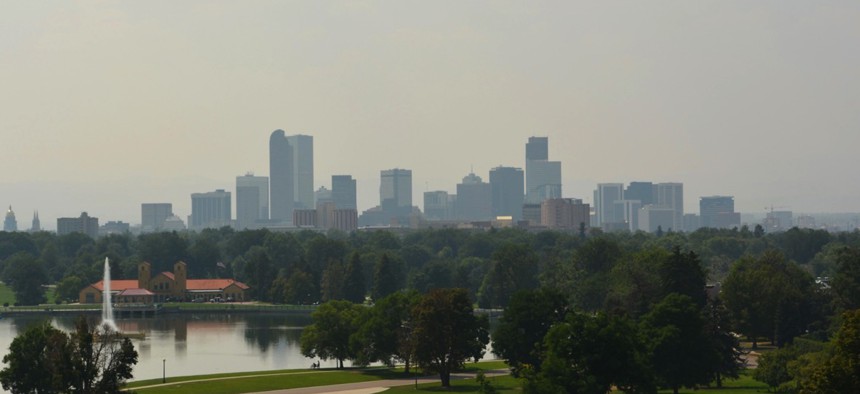Why Cities Should Get Smart About Their Environments

A hazy day in Denver, Colorado.
Getting “smart” about environmental monitoring doesn’t just put a city at the forefront of cutting-edge technology, it could also mean life or death for its residents.
The environment is currently one of the most talked-about topics in America. Rising temperatures and sea levels have citizens worried about the future, and they expect both the private and public sectors to do their parts in promoting safe, healthy ecosystems.
Environmental data naturally plays a vital role in this endeavor—and thanks to the Internet of Things, these insights are more readily available than ever.
In recent years, cities have piggybacked on various governmental agencies and their networks of sensors spread throughout the country. For example, the Environmental Protection Agency has set up more than 10,000 air-quality measurement sensors across the nation, and the data they collect are compiled into reports on a public-facing website. City leaders can easily log on and download air quality index insights on demand.
However, while “more than 10,000 sensors” may sound sufficient for a country that has 50 states, it really isn’t.
California, for example, has a grand total of 970 air quality index reporting sites spread throughout its 483 cities and towns. Larger cities like San Diego and Los Angeles have about 20 sensors each, while many small towns don’t have any sensors at all.
As one could imagine, the cities with few or no sensors have little to no access to relevant and useful air-quality data. Hyper-localized trends are impossible to identify, and regional trends lack granularity. Cities cannot pinpoint exactly where pollution is coming from — and this makes it difficult to identify the perpetrators, hold them accountable, and remedy the situation.
The good news is that municipalities of all sizes can easily overcome these shortcomings by creating their own IoT infrastructures and becoming smart cities.
Unlocking Environmental Insights
Strategically placing sensors throughout a municipality doesn’t just result in deeper data; it also results in accountability and meaningful change. Unlike before, city leaders gain the ability to zero in on specific environmental hot spots, identify the responsible parties, and take necessary steps to address the issues.
Here are three specific environmental factors smart cities can effectively monitor through an investment in IoT technology:
1. Allergens. A whopping 45 million Americans suffer from seasonal allergies, and 25 million suffer from asthma — a condition that causes 250,000 deaths across the globe every year. Allergens exacerbate asthma, so having access to in-depth, accurate data in this realm is pivotal to the health of many citizens.
IoT sensors can help governments better understand local allergen trends and how they may affect residents. Chicago is doing this with its Array of Things initiative. Eight of the city’s IoT sensors have been specifically designated to study the correlation between air-quality levels and asthma.
2. Sounds. By using the IoT to monitor the various sounds of a city, municipalities can improve their crime response times or lower their crime rates altogether. Every noise—from a gunshot to a car horn—has a unique wave form, and through algorithms, IoT sensors can be programmed to capture, recognize, and inform relevant parties when specific sounds occur.
For example, if multiple sensors register the sound of a gunshot, they can automatically determine the exact street corner it came from and instantaneously deliver that data to the local police department. This capability greatly improves response times, as police no longer need to wait for a 911 call in order to learn pertinent information. Washington, D.C., began using this technology in 2006, and at least 30 additional cities — including New Orleans, Newark, and Los Angeles — have followed suit since.
3. Heat. Many large cities experience what is known as the “urban heat island” effect, a phenomenon that causes temperatures to spike drastically. Some sections of a city could be upwards of 20 degrees warmer than others — a highly dangerous situation in the summer months, to say the least.
A city with IoT sensors installed throughout its neighborhoods can learn exactly where its heat islands are and exactly when these temperature spikes tend to occur. Further, they can take preventive measures — such as installing water fountains or creating more shaded areas — to limit the danger during these times.
Getting “smart” about environmental monitoring doesn’t just put a city at the forefront of cutting-edge technology; it could also mean life or death for its residents. From lowering pollution to fighting crime, smart cities save lives in very real ways.
John Horn is the CEO of Ingenu and has served as president of RacoWireless, a leading provider of machine-to-machine connectivity solutions, and as a leader at T-Mobile, where he focused on developing the company’s M2M program and go-to-market strategy.
NEXT STORY: Chicago’s Hands-On Approach to Innovation Accelerators





